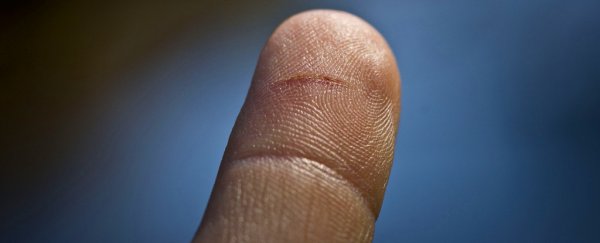You wouldn't think that a flimsy piece of paper could inflict such sharp pain on the human body, but of all life's little annoyances, paper cuts are one of the worst.
While not overly serious in the grand scheme of things, they sure provide a lot of pain for such a minor injury. So why do paper cuts hurt so much, even if they don't pierce the skin?
Turns out, it's your nerve endings that are mainly to blame: we've got more pain receptors in the tips of our fingers than almost anywhere else in the body, which you might have already realised if you've ever tried to pick up something very hot.
"Fingertips are how we explore the world, how we do small delicate tasks," dermatologist Hayley Goldbach from the University of California, Los Angeles, told Jason G. Goldman at the BBC. "So it makes sense that we have a lot of nerve endings there. It's kind of a safety mechanism."
These nerve endings are called nociceptors, and they warn the brain – through the sensation of pain – about high temperatures, dangerous chemicals, and pressure that could break the skin.
Some blame also lies with the paper, though – paper edges are not as smooth as they might appear from a distance, and can leave a rough trail of destruction on the skin, rather than a good, clean nick.
Finally, paper cuts are usually not deep enough to activate the body's natural defence mechanisms – such as blood clotting and scabbing – so the damaged nerve endings in our fingers are left exposed.
Not only that, but the open wound is flexed and strained every time we use our hands until the skin is repaired.
All of which means that paper cuts are disproportionately painful – or at least, that's what we can assume based on the limited evidence we've got. In the absence of a queue of volunteers lining up to slice open their fingers with paper, scientists have to use what they already know about the body to take an educated guess.
"We can use our knowledge of human anatomy to help us out here," said Goldbach. "It's all a question of anatomy."
But you can do a little scientific experimentation on yourself to personally examine the hypothesis. Get hold of a paperclip, then bend it so the two ends are close together and pointing in the same direction.
Try poking your back or legs and see if you can distinguish between the two sharp points, then try again on your hands or your face. It's much easier to feel both points the second time around because of the extra nerve endings.
Congratulations – you just discovered two-point discrimination, which is the ability to recognise two distinct impressions on the skin, and not confuse them as one.
In Scientific American's Instant Egghead video below, researchers suggest that there could be a psychological element to paper cuts as well: in our minds, the pain is made all the more acute because it was caused by something so small and apparently harmless.
So now you know the science behind paper cuts. But the most important tip? Exercise extreme caution around stationery.

A version of this article was first published in September 2016.
